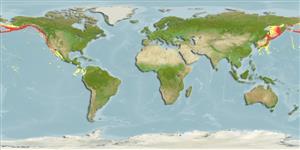>
Perciformes/Scorpaenoidei (Scorpionfishes) >
Sebastidae (Rockfishes, rockcods and thornyheads) > Sebastolobinae
Etymology: Sebastolobus: Greek, sebastes = august, venerable + Greek, lobos = lobe (Ref. 45335); alascanus: Species name after Alaska, the type locality (Ref. 27436).
More on author: Bean.
Environment: milieu / climate zone / depth range / distribution range
Ekologi
marina bottenlevande; djupintervall 17 - 1600 m (Ref. 50550), usually 91 - ? m (Ref. 2850). Temperate
North Pacific: Sea of Okhotsk north to the Navarin Canyon in the Bering Sea and from Stalemate Bank and Ulm Plateau in the Aleutian Islands southeast to Cedros Island, Baja California, Mexico. Reported from Japan (Ref. 559).
Length at first maturity / Size / Vikt / Age
Maturity: Lm 22.0 range ? - ? cm
Max length : 80.0 cm SL hane/ej könsbestämd; (Ref. 559); publicerad maxvikt: 9.0 kg (Ref. 56527); rapporterad maxålder: 100 år (Ref. 90032)
Taggstrålar i ryggfenan (totalt): 15 - 17; Mjukstrålar i ryggfenan (totalt): 8-9; Taggstrålar i analfenan 3; Mjukstrålar i analfenan: 4 - 5. Head spines very strong - nasal, preocular, supraocular, postocular, tympanic, parietal and nuchal spines present, coronal spines absent; large head and elongate body; strong spiny ridge on head; 3rd dorsal spine not much longer than 2nd, 4th or 5th; strong notch on pectoral fin (Ref. 27437). Bright red with some black on fins; gill chamber mostly pale (Ref. 27437). Caudal slightly rounded (Ref. 6885).
Very common on soft bottoms (Ref. 2850). Oviparous (Ref. 205). Eggs are extruded in floating gelatinous masses (Ref. 31279). Have a thick glandular tissue on posterior margin of fin spines which is believed to be venomous (Ref. 57406). Rarely taken by game fishers (Ref. 27436). Flesh sweeter than that of other rockfishes (Ref. 27436).
Unlike other representatives of this group, this species has internal fertilization Oviparous (Ref. 6885). Females possess specialized ovarian structures including stalk-like ovigerous lamellae and secretory epithelia (Ref. 32832).
Eschmeyer, W.N., E.S. Herald and H. Hammann, 1983. A field guide to Pacific coast fishes of North America. Boston (MA, USA): Houghton Mifflin Company. xii+336 p. (Ref. 2850)
IUCN Red List Status (Ref. 130435)
Human uses
Fiskeri: mindre kommeriell
Ytterligare information
referenserVattenbrukVattenbruksprofilAvelslinjerGenetikElectrophoresesÄrftlighetSjukdomarBehandlingNutrientsMass conversion
MedarbetareBilderStamps, Coins Misc.LjudCiguateraHastighetSimsättGälytaOtolithsHjärnstorlekSyn
Verktyg
Special reports
Download XML
Internet-källor
Estimates based on models
Preferred temperature (Ref.
123201): 1.2 - 6.7, mean 3.8 °C (based on 417 cells).
Phylogenetic diversity index (Ref.
82804): PD
50 = 0.6250 [Uniqueness, from 0.5 = low to 2.0 = high].
Bayesian length-weight: a=0.00708 (0.00408 - 0.01228), b=3.16 (3.00 - 3.32), in cm total length, based on LWR estimates for this species & (Sub)family-body (Ref.
93245).
Trofisk nivå (Ref.
69278): 3.6 ±0.3 se; based on diet studies.
Generation time: 47.8 ( na - na) years. Estimated as median ln(3)/K based on 1
growth studies.
Resiliens (Ref.
120179): Mycket låg, lägsta populationsfördubblingstid mer än 14 år (tmax> 100 (validated age: 62 yrs); tm= 13; Fec > 10,000).
Prior r = 0.02, 95% CL = 0.01 - 0.03, Based on 1 stock assessment.
Fishing Vulnerability (Ref.
59153): High vulnerability (59 of 100).
Climate Vulnerability (Ref.
125649): Moderate vulnerability (38 of 100).
Nutrients (Ref.
124155): Calcium = 18.4 [8.0, 49.9] mg/100g; Iron = 0.287 [0.128, 0.565] mg/100g; Protein = 17.5 [15.8, 19.3] %; Omega3 = 1.01 [0.41, 2.73] g/100g; Selenium = 29.6 [13.0, 73.1] μg/100g; VitaminA = 13.5 [3.9, 44.9] μg/100g; Zinc = 0.518 [0.305, 0.810] mg/100g (wet weight);
